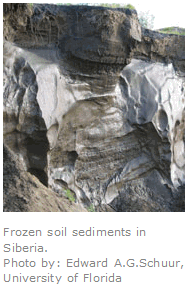
|
|
|
|
|
|
|
News & Views item - July 2009 |
![]() CSIRO Contributes to Analysis Consistent With Permafrost Melt Posing Major
Contribution to Climate Change. (July 2, 2009)
CSIRO Contributes to Analysis Consistent With Permafrost Melt Posing Major
Contribution to Climate Change. (July 2, 2009)
In a paper published in the latest edition of Global Biogeochemical Cycles "Soil organic carbon pools in the northern circumpolar permafrost region" researchers from Canada, Australia, the USA, Sweden and Russia have developed the "Northern Circumpolar Soil Carbon Database"* in order to determine carbon pools in soils of the northern circumpolar permafrost region -- a region of approximately 18,782 × 103 km2, or approximately 16% of the global soil area.
In total, the northern permafrost region contains approximately 1672 Pg ( 1Pg = 1012 kg = 1 billion tonns) of organic carbon, of which approximately 1466 Pg, or 88%, occurs in perennially frozen soils and deposits. The 1672 Pg of organic carbon would account for approximately 50% of the estimated global below-ground organic carbon pool.
According to the Executive Director of the Global Carbon Project at CSIRO, Dr Pep Canadell, the paper's second author, the amount of carbon stored in frozen soils at high latitudes is double previous estimates and could, if emitted as carbon dioxide and methane, lead to a significant increase in global temperatures by the end of this century.
Dr Canadell said: "Massive amounts of carbon stored in frozen soils at high latitudes are increasingly vulnerable to exposure to the atmosphere. The research shows that the amount of carbon stored in soils surrounding the North Pole has been hugely underestimated. Warmer temperatures at high latitudes are already resulting in unprecedented permafrost degradation. Projections show that almost all near-surface permafrost will disappear by the end of this century exposing large carbon stores to decomposition and release of greenhouse gases".
The models developed using the data indicate that global warming could trigger an irreversible process of thawing.
And Dr Canadell says: "Using the new carbon pool estimates from this research, permafrost degradation could account for the entire upper range of carbon-climate feedbacks currently estimated by climate models. The potential for significant feedbacks from permafrost carbon could be realised with only a small fraction of currently frozen carbon released to the atmosphere. For example if only 10% of the permafrost melts, the resultant feedback could result in an additional 80 ppm carbon dioxide equivalent released into the atmosphere, equating to about 0.7°C of global warming."
A contributing factor would be heat generated from increased microbial activity which could lead to sustained and long-term chronic emissions of carbon dioxide and methane.
_____________________________
*(Tarnocai, C., J. G. Canadell, E. A. G. Schuur, P. Kuhry, G. Mazhitova, and S.
Zimov (2009), Soil organic carbon pools in the northern circumpolar permafrost
region, Global Biogeochem. Cycles, 23, GB2023,
doi:10.1029/2008GB003327).